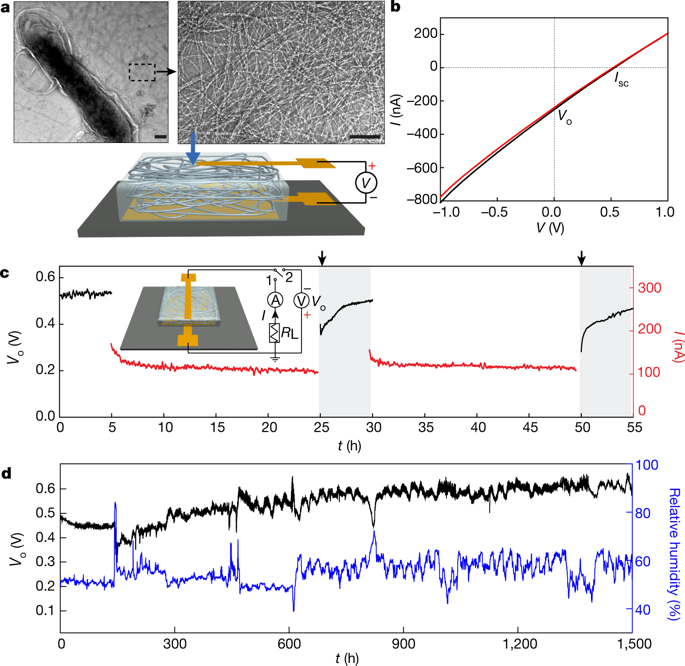Nature ( IF 50.5 ) Pub Date : 2020-02-17 , DOI: 10.1038/s41586-020-2010-9 Xiaomeng Liu 1 , Hongyan Gao 1 , Joy E Ward 2 , Xiaorong Liu 3 , Bing Yin 1 , Tianda Fu 1 , Jianhan Chen 3, 4, 5 , Derek R Lovley 2, 4 , Jun Yao 1, 4

|
Harvesting energy from the environment offers the promise of clean power for self-sustained systems1,2. Known technologies—such as solar cells, thermoelectric devices and mechanical generators—have specific environmental requirements that restrict where they can be deployed and limit their potential for continuous energy production3,4,5. The ubiquity of atmospheric moisture offers an alternative. However, existing moisture-based energy-harvesting technologies can produce only intermittent, brief (shorter than 50 seconds) bursts of power in the ambient environment, owing to the lack of a sustained conversion mechanism6,7,8,9,10,11,12. Here we show that thin-film devices made from nanometre-scale protein wires harvested from the microbe Geobacter sulfurreducens can generate continuous electric power in the ambient environment. The devices produce a sustained voltage of around 0.5 volts across a 7-micrometre-thick film, with a current density of around 17 microamperes per square centimetre. We find the driving force behind this energy generation to be a self-maintained moisture gradient that forms within the film when the film is exposed to the humidity that is naturally present in air. Connecting several devices linearly scales up the voltage and current to power electronics. Our results demonstrate the feasibility of a continuous energy-harvesting strategy that is less restricted by location or environmental conditions than other sustainable approaches.
中文翻译:

使用蛋白质纳米线从环境湿度发电
从环境中收集能源为自持系统1,2提供了清洁能源的承诺。已知技术(如太阳能电池、热电设备和机械发电机)具有特定的环境要求,限制了它们的部署地点并限制了它们连续能源生产的潜力3,4,5。无处不在的大气水分提供了另一种选择。然而,由于缺乏持续的转换机制,现有的基于水分的能量收集技术只能在周围环境中产生间歇性、短暂(少于 50 秒)的能量爆发6、7、8、9、10、11 ,12 . 在这里,我们展示了由从微生物中采集的纳米级蛋白质线制成的薄膜器件Geobacterthioreducens可以在周围环境中产生持续的电力。这些器件在 7 微米厚的薄膜上产生约 0.5 伏的持续电压,电流密度约为每平方厘米 17 微安。我们发现这种能量产生背后的驱动力是当薄膜暴露于空气中自然存在的湿度时,薄膜内形成的自我维持的水分梯度。连接多个设备可以线性扩展电力电子设备的电压和电流。我们的研究结果证明了持续能量收集策略的可行性,该策略比其他可持续方法受位置或环境条件的限制更少。











































 京公网安备 11010802027423号
京公网安备 11010802027423号